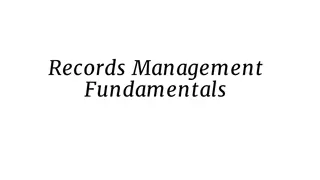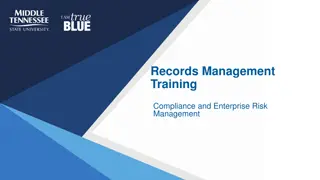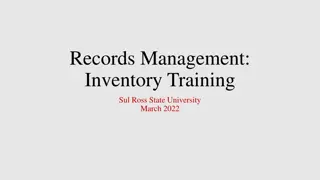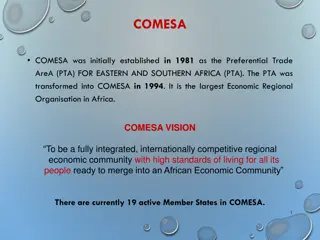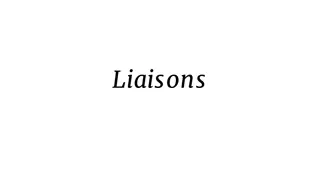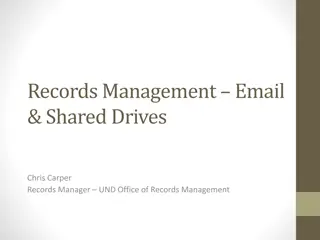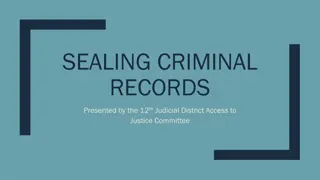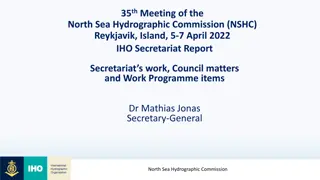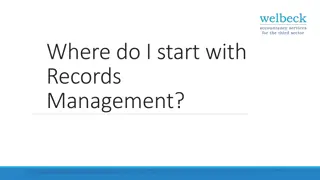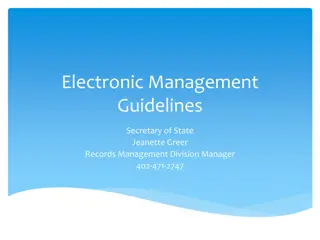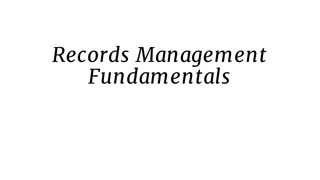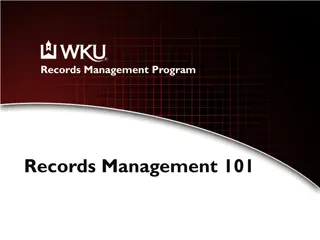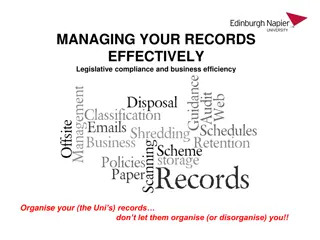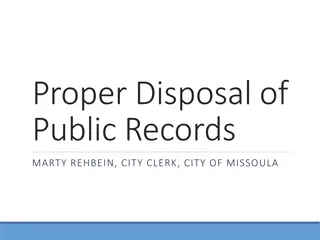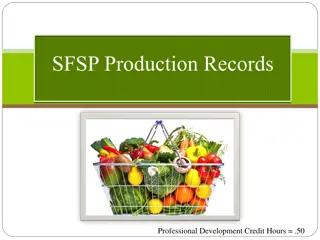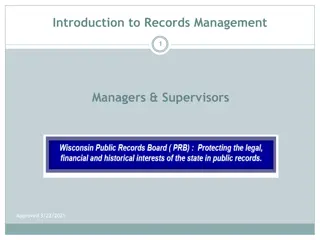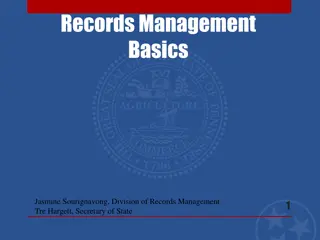Comprehensive Records Management Guidelines for COMESA Secretariat
Explore essential aspects of records management for COMESA Secretariat, including sensitization programs, records retention policies, valuable records identification, information sensitivity classification, and vital records preservation. Learn about the importance of maintaining records with administrative, fiscal, legal, and research value, as well as understanding information sensitivity levels and safeguarding vital records to ensure seamless operations and disaster recovery.
Download Presentation

Please find below an Image/Link to download the presentation.
The content on the website is provided AS IS for your information and personal use only. It may not be sold, licensed, or shared on other websites without obtaining consent from the author. Download presentation by click this link. If you encounter any issues during the download, it is possible that the publisher has removed the file from their server.
E N D
Presentation Transcript
Records Management Sensitization Program Records Management Policy and Records Retention and Disposal Schedules
COMESA Records Management Cycle Archives Create Receive Capture Store Preserve Final Disposition Organise Classify File Destruction Access Use THE COMMON MARKET FOR EASTERN & SOUTHERN AFRICA 2
Identifying Valuable Records Not all records created in the course of Secretariat work need to be kept permanently. Only about 5-10 percent of any organization s records have enduring value as permanent archives. a. Administrative value: Do the records provide evidence necessary to help COMESA Secretariat offices conduct day-to-day business? Records with administrative value might include policies, operational guidelines, Implementation procedures, Council decisions and so on. b. Fiscal value: Do the records establish an audit trail by documenting money received, managed, or spent? Records with fiscal value might include budget policies, the COMESA Secretariat general ledger, or records of contributions from member states c. Legal value: Do the records document the rights or responsibilities of COMESA Secretariat or its personnel? Records with legal value might include signed contracts, land title documents, or records related to trade agreements. d. Research value: Do the records provide important evidence of the COMESA Secretariat activities, programmes and policies, or otherwise serve as the organization s institutional memory? Records with research value might include records of the Secretary General, records related to trade agreements, or ratifications and capacity building, or records of historical milestones in COMESA. THE COMMON MARKET FOR EASTERN & SOUTHERN AFRICA 3
Understanding Information sensitivity and classification Levels STRICTLY CONFIDENTIAL: information or material whose unauthorized disclosure could reasonably be expected to cause EXCEPTIONALLY GRAVE DAMAGE TO or IMPEDE THE CONDUCT OF THE WORK of the COMESA Secretariat. CONFIDENTIAL: information or material whose unauthorized disclosure could reasonably be expected to cause DAMAGE TO THE WORK of the COMESA Secretariat. UNCLASSIFIED: information or material whose unauthorized disclosure could reasonably be expected NOT TO CAUSE DAMAGE TO THE WORK of the COMESA Secretariat. Non-Sensitive Information: Public: information created with the expectation that it will be shared with the public. Unclassified: information whose unauthorized disclosure could reasonably be expected not to cause damage to the work of the Secretariat. THE COMMON MARKET FOR EASTERN & SOUTHERN AFRICA 4
Vital Records operate if they are lost destroyed or cannot be retrieved. Vital records contain information in which in the event of a disaster is essential for continued operation or to restart the business of the Secretariat. Examples of vital records of the Secretariat include' Vital records are those records without which the Secretariat would not continue to a. Legal documents b. Financial records c. Policies d. Personal files e. Operating manuals f. Architectural designs THE COMMON MARKET FOR EASTERN & SOUTHERN AFRICA 5
Information Security Classification The purpose for security classification of records is to: a. b. c. d. Protect COMESA with standard information safeguarding practices. Standardize application of information security tagging. Provide guidance on handling sensitive information within the COMESA Secretariat. Provide assurance to external stakeholders who provide sensitive information to the COMESA Secretariat that the information will be adequately protected. Records of the COMESA taken to be Confidential and Restricted capture information which concerns: Safety of staff, stakeholders and facilities. a. Privacy of staff and stakeholders. b. Regional security. c. Conduct of regional relationships. d. The integrity of the operations of the COMESA Secretariat e. The resolution of political, social and economic problems of the Region f. Vital processes. THE COMMON MARKET FOR EASTERN & SOUTHERN AFRICA 6
Records Retention and Disposal Schedules The Records Retention and Disposal Schedule is issued under the Records Management Policy and the Records Retention and Disposal Guidelines, to of COMESA. direct the retention and disposal of the records The Schedule applies to all records generated by COMESA and its institutions or containing information useful to COMESA, regardless of their physical format, including Paper; electronic; photography; completed forms; drawing; film; and audio. Contents of Retention and Disposal Schedules a) Information description: the description of the information and related records. b) Retention period: the time frame according to which records should be kept before their final disposition. c) Disposal action: the eventual fate defined for records, after they have served their retention period. d) Classification level: the security classification level attached to the information, in accordance with the Information Classification Policy. e) Information owner: the person or group responsible for a specific business function or task and therefore has overall responsibility for the information and records generated from those business function or tasks. THE COMMON MARKET FOR EASTERN & SOUTHERN AFRICA 7
Color Coding in retention Schedules a) Level 1: PUBLIC Green represents information that is available to the public and is intended for distribution outside COMESA. a) Level 2: INTERNAL USE Yellow represents information that is intended for internal use within the COMESA Secretariat and other COMESA Institutions and is protected from external access. a) Level 3: CONFIDENTIAL Red represents confidential information, whose access is limited to specific staff members of the COMESA Secretariat; and other COMESA Institutions and is protected from external access. THE COMMON MARKET FOR EASTERN & SOUTHERN AFRICA 8
End Thanks for your Attention Comments/Questions THE COMMON MARKET FOR EASTERN & SOUTHERN AFRICA 9





